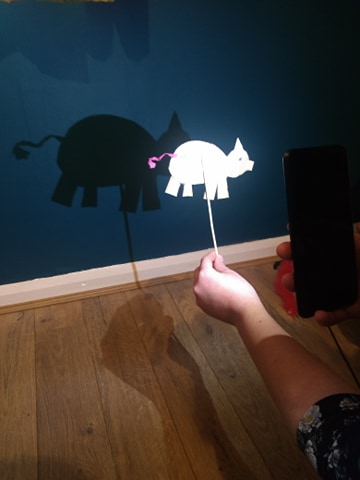
You Will Need
- A torch (a phone torch, bike light or lamp would also work fine)
- A variety of transparent, opaque and translucent objects to test
- A toilet roll or similar size tube to place around the torch
- A slightly darkened room
The Experiment
You can download a word search for this activity here.Start off by shining the torch at a bit of wall or floor and talking about where the light goes. Older children may already know that light appears to travel in a straight line. Next take some items from around the house and see what happens when you shine the torch through them. You may want to explore;
- which objects block the light and make a shadow
- which objects block some light and change the colour of the light
- which objects let all or almost all of the light through
- how the size of the shadow changes depending how far from the torch you place the object
- if you can predict what a shadow will look like for a particular object
- finding different objects in the house together that you think will make interesting shadows
Going Further
With older children you may want to introduce some maths and draw a graph! You will need: A tape measure or ruler Help your child to measure the height or the object they are testing then from 1m away shine the torch at the wall. Your child can then measure the height of the shadow. Try this for several items and see if they can find a relationship (dividing the height of the shadow by the height of the object may help!).Getting Crafty
You will need: Scissors, glue, paper, card, other decorations, some sellotape and a skewer or stick to mount it on. Now you have explored the properties of different objects it might be fun to make some shadow puppets! You can use card/paper/sweet wrappers or whatever you have to hand to change what the shadow looks like and cut out different shapes to make them look like people, animals or plants!
What scientists do
There is a whole group of scientists called “analytical scientists” and even “analytical chemists”. Their job is to work out what different things are made of or what they contain. To do this they may shine light, or sound waves or other types of radiation at the object and study what happens. They study lots of different materials and compare how they behave to try to find patterns just like you do in this experiment! We can use analysis to learn about things that exist naturally in the world around us, in our bodies (for example testing peoples blood or saliva) or for testing things that are man made like food or medicines to check that they don’t contain anything nasty in them.Curriculum
From Y3 children should be learning to;- recognise that they need light in order to see things and that dark is the absence of light
- notice that light is reflected from surfaces
- recognise that light from the sun can be dangerous and that there are ways to protect their eyes
- recognise that shadows are formed when the light from a light source is blocked by an opaque object
- find patterns in the way that the size of shadows change
- recognise that light appears to travel in straight lines
- use the idea that light travels in straight lines to explain that objects are seen because they give out or reflect light into the eye
- explain that we see things because light travels from light sources to our eyes or from light sources to objects and then to our eyes
- use the idea that light travels in straight lines to explain why shadows have the same shape as the objects that cast them
 This work is licensed under a Creative Commons Attribution 4.0 International License.
This work is licensed under a Creative Commons Attribution 4.0 International License. 






